ELECTROLYTES docx
Bạn đang xem bản rút gọn của tài liệu. Xem và tải ngay bản đầy đủ của tài liệu tại đây (130.25 KB, 6 trang )
ELECTROLYTES
Contents
Overview
Gel
Ionic Liquids
Non-Aqueous
Polymer
Solid: Mixed Ionic-Electronic Conductors
Solid: Oxygen Ions
Solid: Protons
Solid: Sodium Ions
Overview
M Salomon, MaxPower, Inc., Harleysville, PA, USA
& 2009 Elsevier B.V. All rights reserved.
Introduction
The electrolyte solution is a major component of all
battery systems and as such will greatly influence energy
densities (thermodynamic properties such as Gibbs en-
ergy, enthalpy, and ionic activity) and power densities
(nonthermodynamic properties such as viscosity, con-
ductivity, and transference). The electrolyte solution
consists of a liquid or solid phase containing at least one
component, e.g., water, which is called the solvent, and an
ionizable substance, e.g., a salt or an acid, which is called
the electrolyte. The fundamental thermodynamic and
nonthermodynamic concepts that are of importance to
batteries are discussed below.
Thermodynamic Fundamentals
Standard Electrode Potentials
A battery is defined as a string of individual Galvanic cells,
and the basic cell consists of two electrodes (half-cells)
immersed in a solution containing an electrolyte com-
posed of ions reversible to each of the half-cells. The cell
reaction is
Li þAgCl $ Li
þ
þ Cl
À
þ Ag ½I
In aqueous solution, the two half-cell reactions can be
written in terms of standard potentials as
Li$Li
þ
þ e
À
ðoxidation e:m:f:Þ; E
o
¼þ3:045 V
Li
þ
þ e
À
$Li ðreduction e:m:f:Þ; E
o
¼À3:045 V
AgCl þe
À
$Cl
À
þ Ag; E
o
¼þ0:2223 V
where the E
o
values are standard potentials (in units of
volts) as indicated by the superscript and thus refer to
STP (standard temperature (298.15 K) and pressure
(101.33 kPa)), and the concentration or activity of the
electrolyte is unity. Under these conditions, the cell po-
tential (e.m.f.) for reaction [I] is written as
E
o
¼ E
o
ðoxidationÞþE
o
ðreductionÞ
and using the half-cell e.m.f.’s given above, the e.m.f. of cell
[I] is E
o
¼3.045 þ0.2223 ¼3.267 V. For many half-cells,
standard e.m.f.’s, particularly for aqueous solutions, have
been tabulated in various text books on thermodynamics
and electrolytes. The value of 2.823 V is the standard e.m.f.
for cell [I], but in practice, the observed e.m.f. for this cell
will be dependent upon the concentration of the electro-
lyte in the electrolyte solution, or, more accurately, upon
the activity of the electrolyte in the electrolyte solution.
Provided the activities of all ionic species in solution are
known or can be calculated from theoretical expressions,
the e.m.f., E, of the Galvanic cell can be calculated from
the Nernst equation
E ¼ E
o
À
RT
nF
ln
Pa
products
Pa
reactants
&'
½1
where R is the g as constant, T the absolute temperature, n
the number of electrons involved in the electrochemical
reaction, and a the activities of initial reactants and final
products as indicated in eqn [I]. A discussion on activities
and concentrations is given below.
There are numerous instances where tabulated e.m.f.
values are not available, but it is still possible to calculate
134









